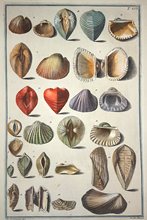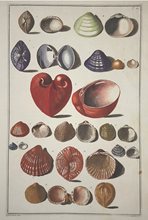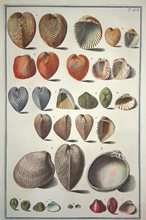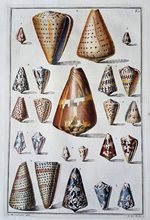
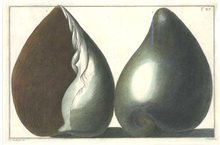
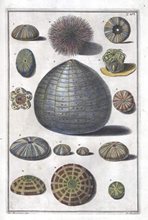
The wonderful antique prints of shells for Gualtieri's Conchology were published in Florence in 1742. Groups of marine life were artistically arranged, with some shells standing on end and casting small shadows. The illustrations combined scientific observation with an aesthetic appreciation of display.
Most of the Gualtieri shell groups were engraved on copper by Italian artist-engraver, Abbot, Pietro Antonio Pazzi (1706-1766). The main draftsman for these engravings was Giuseppe Menabuoni (1708-1745). They proved to be so popular that they were republished in 1748 and 1760.
All three editions of Gualtieri Conchology were published uncoloured. While the page size varied very slightly between editions, and individual plate sizes also varied very slightly, the page size is around 45.5 x 32.5cm (18 x 12.3/4 inches), and the intaglio impression is around 37 x 24cm (14.5 x 9.5 inches). These beautiful engravings of Gualtieri Shells, particularly those with later hand-colour, are some of the most decorative natural history artwork. It is a pity they are so rare.
Niccolo Gualtieri (1688-1744) was a professor at the University of Pisa, and medical physician to Cosimo III, Grand Duke of Tuscany. The Duke was also an avid collector of shells, and gave Gualtieri shells from his own collection when he had more than one specimen of each.
Eminent zoologists, including Jean-Baptiste Lamarck (1744-1829), commended the system that Gualtieri devised for the classification of molluscs. Swedish botanist, physician and zoologist, Carl Linnaeus (1707-1778), who founded the modern system for classification of plants and other organisms using binomial nomenclature, used many of Gualtieri's shells in the 10th edition of his Systema Naturae when he described his own system of taxonomy.
Such is the public fascination with shells, and so high was the respect for Niccoli Gualtieri's collection, that 700 of his collected specimens are housed today at the Museo Storia Naturale di Pisa (the Natural History Museum of Pisa), which is part of the University of Pisa, now located in Pisa Charterhouse, 10km from the city of Pisa in the municipality of Calci in Italy.
The grandest of these superbly decorative engravings look fantastic individually in large frames, and the exquisitely detailed groups of the smallest shells look really lovely - whether hanging individually or as a group. When we have been fortunate to have the coloured examples of Gualtieri's shells, they have usually not been available for very long.. so choose now while they are still available.. /Products/Antique-Prints/Marine-Life/Shells-Starfish-Crustaceans-Coral.asp
